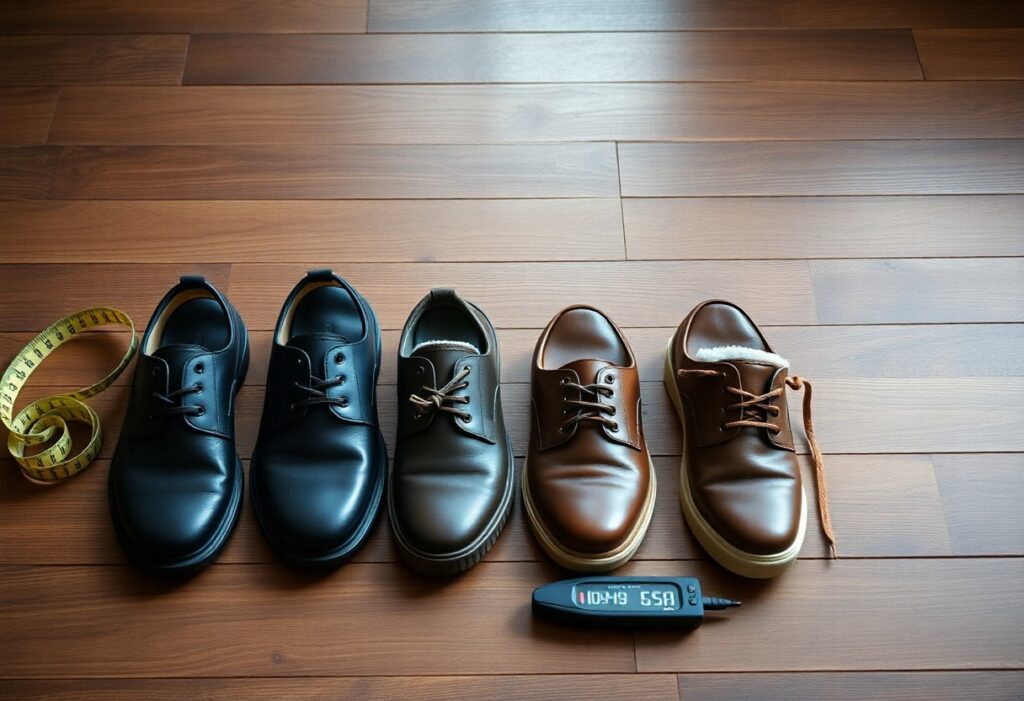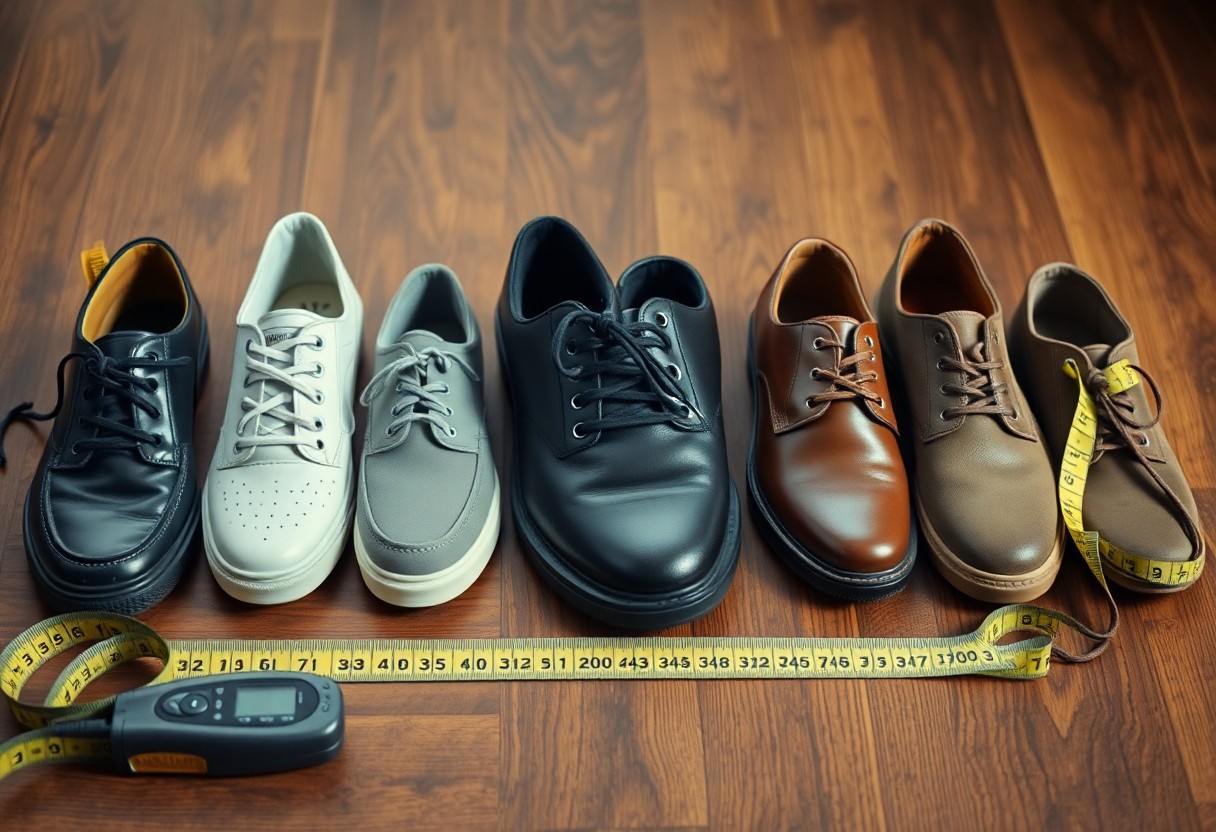
Recognizing the significance of selecting shoes with the perfect width is crucial for safeguarding your foot health. Properly fitting shoes can dramatically alleviate foot pain and avert various health issues. When on the hunt for new footwear, it’s vital to take into account both the length and width to ensure an optimal fit. Choosing shoes that are the right width not only improves your stability and blood flow but also minimizes the risk of developing blisters and other common foot ailments. To determine your ideal shoe width, measure the broadest part of your foot and consult standardized width charts. Many shoppers mistakenly focus only on length, overlooking the fact that adequate width is essential for daily comfort and overall foot health.
Step-by-Step Guide to Measure Your Feet for the Perfect Fit
The most reliable way to ascertain your shoe width is to measure your feet at the end of the day when they are likely to be at their largest due to slight swelling. Foot width can vary by as much as half an inch throughout the day, so evening measurements yield the most dependable results. To do this, stand on a sheet of paper and trace around your foot, ensuring you capture the most precise outline possible. This straightforward technique can guide you in finding shoes that not only fit comfortably but also provide the essential support your feet require throughout the day.
Effective Techniques for Accurate Foot Width Measurement
Besides using a conventional ruler, consider employing a Brannock Device, a specialized instrument commonly found in shoe stores that accurately measures foot size. This tool enables you to measure the widest part of your foot, which is usually located across the ball area. For the best results, it’s crucial to measure both feet while standing, as it is normal for one foot to be slightly larger than the other. By doing so, you can ensure that you select shoes that accommodate the larger foot, thus preventing discomfort during wear and contributing to overall foot health.
Avoiding Common Pitfalls in Shoe Width Selection
One of the most common mistakes made when choosing shoe width is overlooking the importance of accurate width measurements. Many individuals focus solely on foot length, which can result in discomfort and a myriad of potential foot problems. Other frequent errors include measuring feet while seated and assuming that foot width remains unchanged throughout life. It’s crucial to understand that wearing shoes that are too narrow can lead to serious foot issues such as bunions, corns, and hammertoes. Foot size can change due to factors like weight gain, pregnancy, or aging, so it’s advisable to measure your feet annually. Selecting the appropriate width can help avoid blisters, calluses, and persistent foot discomfort.

Decoding Shoe Width Systems for the Best Fit
Gaining a clear understanding of the various shoe width systems is essential for ensuring comfort and optimal foot health. Different brands and countries use unique measurement standards, so familiarizing yourself with these systems can help you select shoes that fit correctly and prevent foot-related issues. By learning how width is categorized, you can make informed choices when selecting footwear that caters to your specific requirements.
Understanding Letter-Based Width Scales for Ideal Shoe Fit
When browsing for shoes, you will often find widths labeled from AA to EE. For women, a standard medium width is B, while for men, it is D. Narrow widths are categorized from AA to B, whereas wide widths extend from D to EE. This letter-based classification system is intended to help you identify the most suitable fit based on your foot shape, ensuring that your footwear feels comfortable and provides the necessary support throughout the day.
Understanding International Width Measurement Standards
When shopping internationally, you may encounter a variety of measurement systems. For example, European sizes are calculated in millimeters, while UK sizes adhere to their own width guidelines. Your US shoe size can differ from international sizes by one to two width sizes, making it vital to always refer to the brand’s size chart when purchasing shoes from abroad. Shoes from Japan tend to be narrower, while European brands often feature a wider toe box. To achieve the best fit, measuring your feet in millimeters offers the most precise reference for international purchases.

How Shoe Design and Construction Impact Fit and Comfort
To make informed footwear selections, it’s essential to understand how shoes are constructed. The way a shoe is designed significantly affects how it fits and feels on your feet. Your overall comfort is heavily influenced by how the upper part of the shoe connects to the sole and the flexibility of the materials used around the widest part of your foot. By opting for shoes with thoughtful construction, you can enhance comfort and support, ultimately contributing to better foot health.
The Advantages of Natural Materials in Footwear
Shoes crafted from genuine leather offer remarkable breathability and adaptability. Leather has a unique ability to stretch and mold to your foot shape over time, resulting in a customized fit. Studies indicate that leather shoes can expand by as much as 30% of their original width, making them a favorable choice for individuals with varying foot widths who prioritize comfort and flexibility.
The Durability and Consistency of Synthetic Shoe Materials
Synthetic materials available today provide consistent width measurements and exceptional durability. These modern materials not only protect your feet but also offer water resistance and enhanced breathability. Many synthetic shoes now incorporate mesh panels that improve airflow and flexibility. Additionally, advances in synthetic materials have led to the integration of comfort features like memory foam and gel inserts. Consequently, shoes can now combine stable width measurements with targeted cushioning, ensuring superior support during wear. Recent research shows that synthetic materials can maintain their shape up to 40% longer than traditional materials, guaranteeing your shoes retain their correct width throughout their lifespan.

Recognizing Indicators of Proper Shoe Width for Maximum Comfort
Unlike length, the appropriate shoe width is evident in how your feet feel and function within the shoe. Your shoes should allow your toes to spread naturally while walking, with about half an inch of space at the shoe’s widest point. Research reveals that 70% of individuals wear shoes that are incorrectly fitted in terms of width, leading to various foot-related problems. Learning to recognize the signs of proper width can guide you in making better footwear choices for your comfort.
Key Signs Indicating Comfort from Proper Shoe Width
Here are essential indicators that your shoes fit correctly in width: your toes should be able to wiggle freely, the ball of your foot should align comfortably with the widest part of the shoe, and there should be no pinching on the sides. A well-fitting shoe allows your feet to expand naturally throughout the day, as your feet can swell by up to 8% by day’s end. Ensuring you have the correct width can dramatically enhance your walking experience.
Warning Signs That Indicate Incorrect Shoe Width
While wearing shoes regularly, it’s crucial to be alert for warning signs such as numbness or tingling in your toes, blisters on the sides of your feet, and marks left on your skin after removing your shoes. These symptoms are telltale signs that your shoes may not fit properly in width. Proper width is vital for maintaining foot health, as research indicates that ill-fitting shoes can lead to long-term foot complications. You should not experience any pressure points while standing or walking; if you encounter pain, redness, or if your foot spills over the edges of the shoe, it may be time to explore a different width.
Understanding Width Differences Across Shoe Brands
Many footwear manufacturers offer a range of width options, spanning from AA (super narrow) to 4E (extra wide). It’s important to note that foot width can fluctuate throughout the day, and studies indicate that up to 70% of individuals have varying widths between their left and right foot. Recognizing these differences will empower you to select shoes that accommodate your unique foot shape and prevent discomfort and potential foot complications.
The Influence of Brand Variations on Shoe Width Measurements
When examining different brands, you might notice considerable discrepancies in width measurements. A medium width in one brand could feel noticeably narrow in another. European brands often run narrower compared to American brands, while athletic footwear companies typically offer the widest array of width options. It’s always prudent to try on shoes before making a purchase, as sizes can vary substantially between manufacturers.
How Shoe Style Affects Width Fitting and Comfort
The style of a shoe significantly impacts how width fits your foot. Athletic shoes generally provide more flexibility in width compared to dress shoes, while sandals are designed to accommodate a more natural foot width. Your foot width requirements may shift depending on the shoe’s intended purpose and the activities you plan to engage in. Further examination reveals that specific styles necessitate particular width considerations. For instance, high heels require a secure fit to prevent slipping, while work boots may need additional width for comfort with thicker socks. Running shoes should allow for approximately half an inch of space between your longest toe and the shoe’s tip to ensure both comfort and performance.
Recognizing Unique Width Needs for Specialized Foot Requirements
While standard sizing options prevail, some individuals may require specific width adjustments. If you suffer from conditions like bunions, flat feet, or experience swelling, wider shoes may be necessary. Additionally, your foot width can change over the course of the day, with studies suggesting a potential 4% increase in foot volume by evening. Acknowledging these variations is essential for selecting shoes that remain comfortable throughout your daily activities.
Foot Conditions That Necessitate Special Width Accommodations
Special width needs frequently arise due to medical conditions. For those with diabetes, arthritis, or edema, it’s crucial to choose shoes with extra width allowances to enhance circulation. Healthcare professionals may recommend specific width measurements to avoid complications linked to these conditions. Studies show that 75% of individuals with foot ailments benefit from specialized width fittings, highlighting the critical nature of appropriate footwear.
Activity-Specific Width Requirements for Optimal Athletic Performance
Leading an active lifestyle demands different shoe widths for various activities. For instance, your running shoes may need more width than your casual footwear, while hiking boots require enough space to accommodate thicker socks. Athletes often benefit from shoes that are half a size to a full size wider for high-impact activities, allowing for necessary foot expansion during performance. In activity-specific fitting, consider your foot’s natural movement patterns. While running, your feet can expand by up to half a size wider. For sports that involve lateral movements, such as tennis or basketball, adequate width is crucial to prevent foot strain and potential injuries. Your selections should align with your activity level and unique foot characteristics.
Discovering Your Ideal Shoe Width for Long-Lasting Comfort
The secret to uncovering your ideal shoe width lies in understanding effective measurement techniques and the available width options. By measuring your feet at their widest point, knowing your width category (ranging from A to E), and selecting shoes that match your measurements, you can ensure enduring comfort. Your shoes should fit securely without causing pinching or sliding, allowing your toes the freedom to move naturally. By opting for the right width and choosing materials that suit your feet, you can enjoy comfortable, well-fitting footwear that supports all your daily activities.
Answers to Common Questions About Shoe Width
Q: What is the best way to measure my foot width at home?
A: To accurately measure your foot width, place your foot on a blank sheet of paper and trace its outline. Measure the widest part, typically at the ball of your foot, using a ruler. It’s advisable to take measurements in the afternoon when your feet are largest. Be sure to measure both feet, as one may be wider than the other. Use these dimensions to compare with the shoe width charts provided by various manufacturers.
Q: What are the standard width measurements used for shoes?
A: Shoe widths generally employ letter codes from A to E. For women, a standard medium width is B, while for men, it’s D. Narrow widths are indicated by A and AA, while C and D signify medium-wide for women. E and EE represent wider options. Keep in mind that each brand may exhibit slight variations in their width measurements, so it’s prudent to consult their specific size charts prior to purchasing.
Q: How can I tell if my current shoes are the wrong width?
A: Watch for these indicators: red marks on the sides of your feet, numbness in your toes, blisters on your heels or sides, and shoes that slip off while walking. Your toes should have adequate space to wiggle freely, and the ball of your foot should fit comfortably at the shoe’s widest part. If you feel pressure on the sides, it may be time to explore a wider shoe. Conversely, if your foot moves side-to-side within the shoe, you might require a narrower width.
The Article How to choose the right shoe width tips for a comfortable fit appeared first on My Shoes Finder
The Article Choosing the Right Shoe Width for Ultimate Comfort Was Found On https://limitsofstrategy.com


You make such a good point about the importance of shoe width! I used to think that as long as the length was right, I was good to go. But after some painful experiences with blisters and sore feet, I learned the hard way that width is key. Measuring at the end of the day is a great tip; I usually forget that my feet change throughout the day.
You bring up such a relatable experience with shoe fitting. I used to overlook width completely until I found myself dealing with the aftermath of poorly fitting shoes—blisters and that annoying soreness really make you rethink your choices. It’s interesting how many people focus so much on length, yet forget that width can make a huge difference in overall comfort.
I hear you—those lessons about shoe fit can really come from some tough experiences. It’s wild how much our feet can swell during the day, isn’t it? I’ve had my fair share of blisters and discomfort, too, and it’s usually when I’ve been ignoring those signs.
I really appreciate the insights you’ve shared about shoe width and its impact on foot health. It’s a topic that often flies under the radar but is so essential for overall well-being. I remember my own experience – I used to prioritize style over comfort and, as a result, I often found myself dealing with blisters and foot fatigue after just a day of wearing fashionable but ill-fitting shoes. It took me a long time, but I finally learned that investing in footwear that accommodates both length and width is key to not just comfort but also to avoiding long-term foot issues.
Your emphasis on the importance of shoe width resonates deeply with me, particularly as someone who has experienced the repercussions of ill-fitting footwear. It’s surprising how many people tend to prioritize aesthetics over fit, often overlooking the critical role that shoe width plays in both comfort and health.